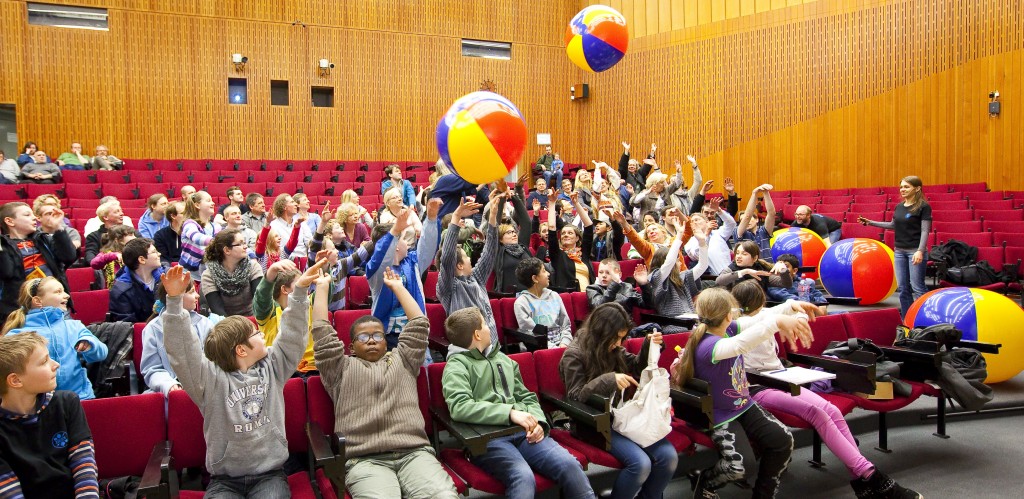
Accelerating 'electrons' – DESY's new accelerator show has the whole audience involved in the demonstration of how a cavity works. Image: DESY, Lars Berg
Picture an auditorium full of schoolkids. When they walk in, they know nothing about superconducting radiofrequency acceleration (and who would blame them). When they walk out, they’re full of acceleration facts and have even been part of a radiofrequency wave that has accelerated an “electron” from one end of the auditorium to the other. How? It’s all thanks to a new stage show about accelerators that is taking off in Germany this year. Called “Rennmaschinen”, it targets schoolchildren of ages 12 and up. Its creators are former particle slam buddies and ILC veterans Brian Foster and Marc Wenskat.
This isn’t the first accelerator show in the world; it is based on “Accelerate!”, which Foster developed together with Suzie Sheehy, a student at Oxford University, before taking up a professorship in Hamburg.
“We really wanted to concentrate on particle acceleration rather than creating another physics show,” says Marc Wenskat. “So we took over the best ideas from the Oxford show, included some of our own, wrote a script and got a team together.” This team now consists of four PhD students or young researchers at DESY, two engineers who volunteered to build some of the show’s things that go bang and fizz, and Foster as the head and the ‘bank’.
So how do they explain superconducting radiofrequency to an auditorium of twelve-year-olds? First of all, the kids are asked to do an ‘ole ole’ wave, where one person stands up and throws his arms up in the air, then the person next to him, and so on so that a wave movement is created by the people in the rows. Once that is routine – it usually only takes two tries – a giant inflatable ball enters the scene. The ball is the electron, the ole ole movement the RF wave, and if you think it’s easy keeping the ball on its path, ask the kids (or any ILC cavity).

The team conceived the experiments and wrote the script themselves. Schools and organisations can book the show online. Image: DESY, Lars Berg.
Most parts of the show are deliberately interactive. The audience is on stage to deflect electrons in an old cathode-ray tube TV screen, explaining a ‘household accelerator’; to dip a toy train into liquid nitrogen and set it off on magnetic tracks, explaining superconductivity; and even to set off the impressive Tesla coils that shoot off sparks and tiny flashes of lightning. All parts put together give them the basic ingredients for a particle accelerator, or at least an understanding for it. “Getting the kids involved is key to what they take home after the show. Teaching is one thing, but a hands-on experience has a much longer-lasting effect,” explains Brian Foster. “Especially if there are bangs and flashes.”
The concept has been tested on several groups of children and is supposed to go on tour once the missing experiments, including a linear accelerator, have been built and the presentation design has been smartened up with some new custom-drawn cartoons. Schools and organisations can book it for free so that the show comes to them, rather than they to the show. It is also self-renewing: new presenters are added so that once the hosts have completed their research projects and move on to other places, the new hosts can take over. So, Wenskat, Foster and their team are constantly looking for new members. They are also currently looking for a coach for show hosting and comic timing. “I already know that accelerator physics is totally exciting, and I want to be able to get that across to the kids,” says Wenskat.
The team wrote the show themselves and tried several options before arriving at the current one. They time the intervals between experiments and give each other clues as to when to say what, still leaving room for improvisation. “The time between the experiments is well defined though,” says Wenskat. “The audience needs time to digest, we need time to explain, but the gaps should not be too long for the show to remain engaging and exciting. One show lasts roughly 50 minutes – a bit longer than a standard lesson at school, but with way more bangs and fizzes.”

Recent Comments